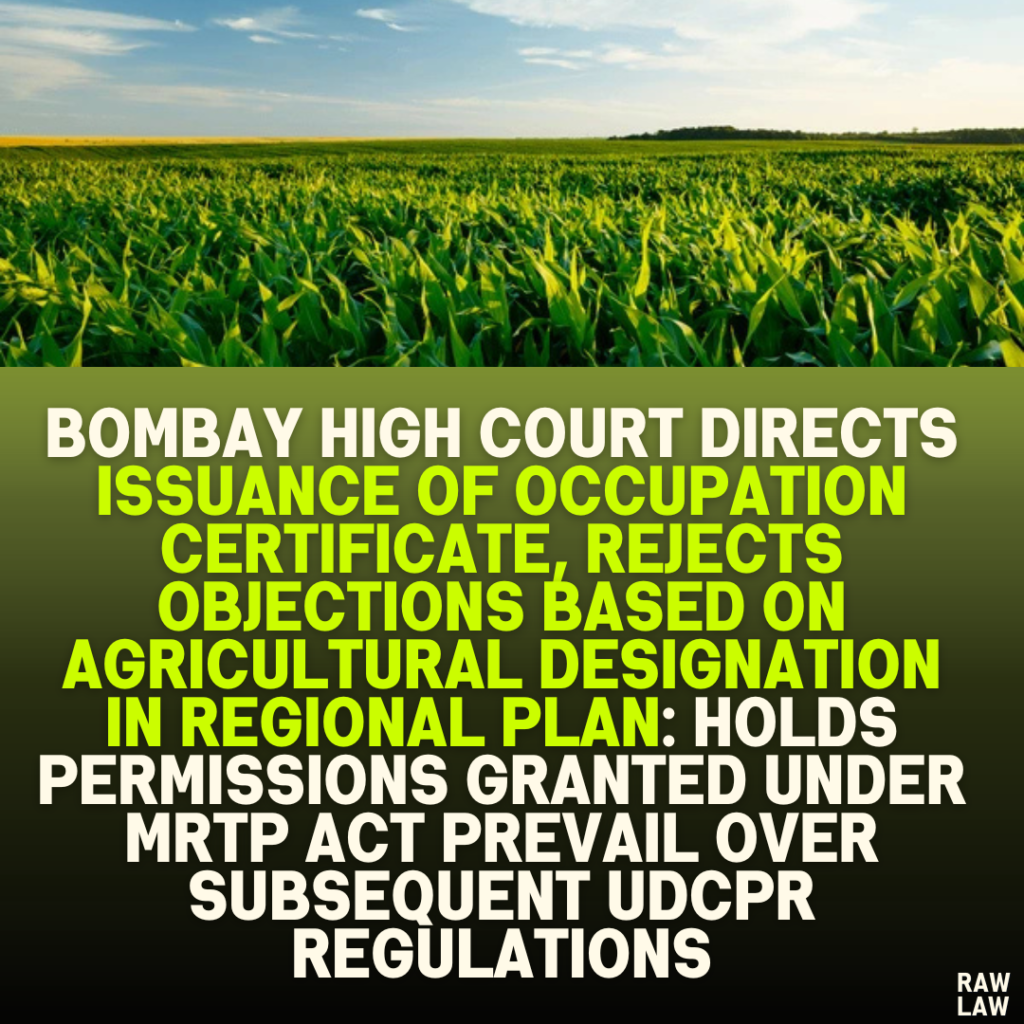Court’s Decision :
The Bombay High Court instructed authorities to issue the Occupation Certificate (OC) to the petitioner for their completed residential-cum-commercial project within eight weeks.
- The court affirmed that permissions granted for land use and development by the Collector in compliance with Section 18 of the Maharashtra Regional Town Planning (MRTP) Act are valid.
- It dismissed objections raised regarding the applicability of the Unified Development Control and Promotional Regulations (UDCPR), stating that subordinate legislation cannot retroactively invalidate valid permissions granted under the MRTP Act.
Facts:
- The petitioner constructed Tulsi Vivaan, a residential project comprising ten seven-storey buildings with 446 residential units and 20 commercial units on land in Karjat, Raigad.
- Timeline of Events:
- 2014: No-objection certificate issued by the Gram Panchayat for construction.
- 2016: Boundaries of the subject land were fixed.
- April 4, 2017: Collector granted development permission for non-agricultural use, one day before the DRP’s publication.
- January 6, 2018: Final Regional Plan sanctioned.
- March 6, 2018: Regional Plan brought into force.
- December 2, 2020: UDCPR enacted.
- The project was completed, and the petitioner applied for the OC in May 2023. However, the application was disposed of without issuance due to administrative delays and doubts regarding regulatory compliance.
Issues:
- Was the refusal to issue the OC justified based on the land’s agricultural designation in the Regional Plan?
- Did the permissions granted before the DRP’s publication remain valid under Section 18 of the MRTP Act?
- Did the UDCPR create new barriers for the issuance of the OC, even though development was completed under earlier permissions?
Petitioner’s Arguments:
- Development and land-use permissions granted by the Collector in April 2017 complied with Section 18 of the MRTP Act.
- The permissions predated the publication of the DRP and the enactment of the UDCPR.
- Withholding the OC was unfair, especially since the project had been completed, and homeowners had already purchased units, many with loans.
Regulation 5.1.3 of the UDCPR allowed developments commenced under earlier permissions to proceed without impediments.
Respondent’s Arguments :
- The land was marked for agricultural use in the Regional Plan, creating doubt about the validity of permissions granted for non-agricultural development.
- The Divisional Office had not provided an opinion on whether the UDCPR’s Regulation 5.1.3 applied to this case, which justified the delay in issuing the OC.
Analysis of the Law :
- This section regulates land-use changes and development after the publication of a Draft Regional Plan (DRP).
- The court found that:
- The Collector granted permissions on April 4, 2017, before the DRP’s publication on April 5, 2017.
- Therefore, the petitioner complied with Section 18’s requirement for prior permission.
- This regulation protects developments commenced before the publication of a DRP or the UDCPR’s enactment.
- The court observed:
- Sub-regulations (i) and (ii) validate permissions granted for residential developments before the UDCPR came into force.
- Sub-regulation (iii) ensures developments in agricultural zones remain valid if approved under earlier laws.
Interplay Between MRTP Act and UDCPR:
- The court harmonized the MRTP Act with the UDCPR, stating that subordinate regulations cannot retroactively negate valid permissions under the parent statute.
Precedent Analysis:
- The court reaffirmed the legal principle that subordinate legislation must align with its parent statute.
- It stated, “Should two views be possible in interpreting subordinate legislation, the view rendering it intra vires must prevail over one that renders it ultra vires.”
Court’s Reasoning:
- Timeliness of Permissions:
- The Collector’s permission was granted before the publication of the DRP.
- Revised permissions were granted before the UDCPR’s enactment.
- Validity of Development:
- Development complied with the terms of permissions granted under the MRTP Act.
- Regulation 5.1.3 supported the continuation of such developments.
- Protection Against Retroactivity:
- The UDCPR did not invalidate permissions obtained before its enactment.
- Administrative delays cannot be justified based on retrospective application of regulations.
Conclusion (Explained in Detail):
The court unequivocally ruled in favor of the petitioner, directing authorities to issue the OC within eight weeks. It held that:
- Permissions granted under the MRTP Act were valid.
- Regulation 5.1.3 of the UDCPR could not impede developments compliant with prior permissions.
Implications (Explained in Detail):
- Clarity in Legal Framework:
- The judgment clarifies that permissions obtained under the MRTP Act remain valid, even after the enactment of the UDCPR.
- It provides a roadmap for harmonizing older and newer regulatory frameworks in land use and development cases.
- Relief for Developers:
- The ruling prevents delays in issuing OCs due to administrative inefficiencies or misinterpretations of new regulations.
- It establishes that developers acting in compliance with prior permissions are protected.
- Safeguarding Homeowners’ Rights:
- The judgment ensures that homeowners are not adversely affected by bureaucratic hurdles, especially when they have made financial commitments.
- It underscores the importance of timely issuance of OCs to uphold consumer rights.
- Guidance for Future Cases:
- The ruling sets a precedent for handling similar disputes where evolving regulations create conflicts with previously granted permissions.
- It emphasizes the need for administrative accountability in adhering to statutory timelines.



